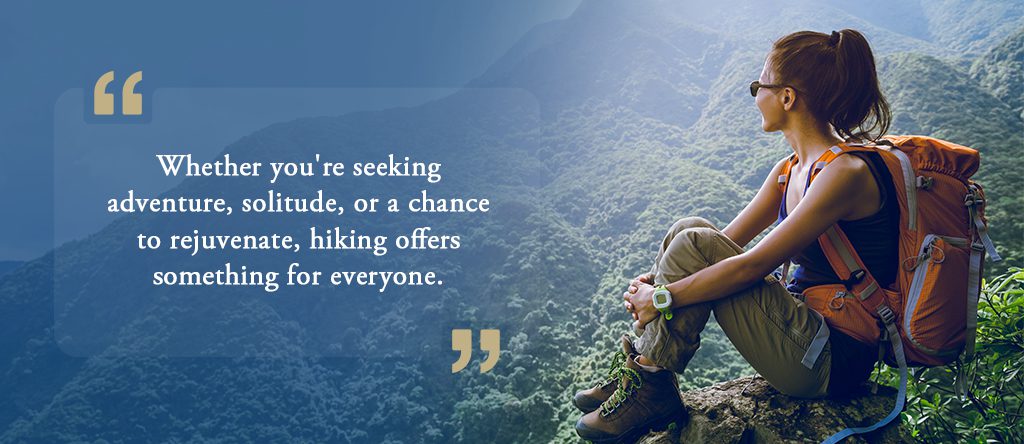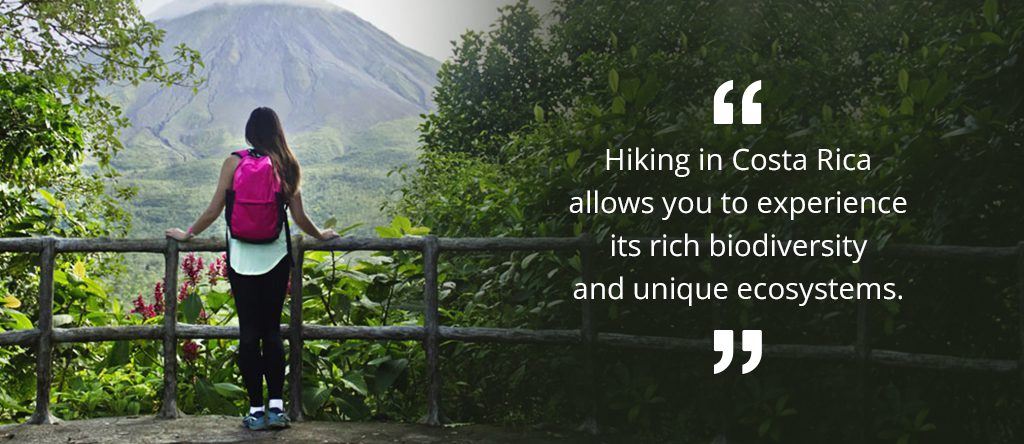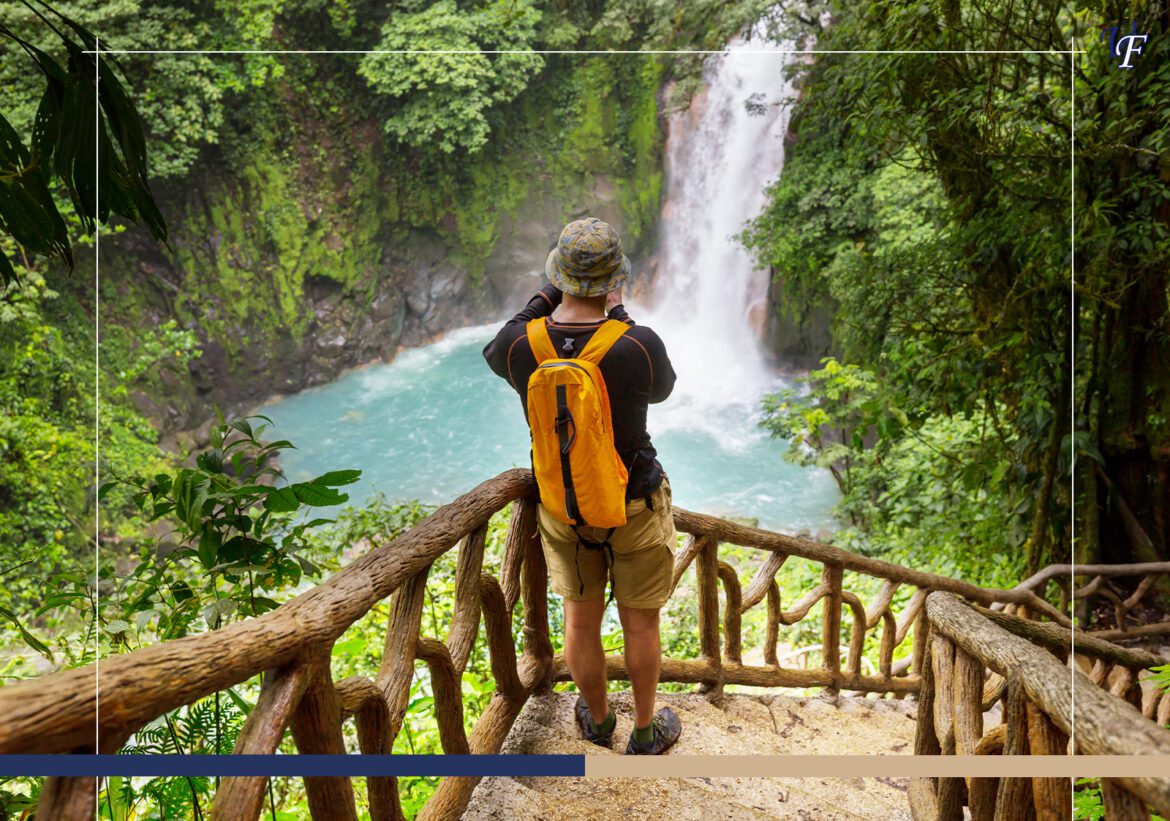Costa Rica is home to over 26 national parks, private reserves, and wildlife refuges, offering travelers phenomenal opportunities to explore and enjoy stunning scenery, landscapes, and wildlife through hiking. From easy coastal walks to challenging mountain climbs, Costa Rica has hiking trails suitable for every level.
Many hikes here lead to natural attractions, such as waterfalls, national parks, beaches, volcanoes, and other stunning viewpoints, with beautiful and diverse natural surroundings that make the journey enjoyable. Costa Rica has hikes to suit all preferences – from a leisure stroll to a challenging trek.

10 Reasons Why Hiking is a Must-Do Activity in Costa Rica
There are several reasons why Costa Rica is considered one of the best places to enjoy hiking. Here are a few of them:
- Stunning natural beauty: With its lush rainforests, pristine beaches, and majestic volcanoes, Costa Rica is home to some of the most breathtakingly beautiful scenery in the world. Hiking through these landscapes will surely be an unparalleled experience.
- Rich biodiversity: Costa Rica is a biodiverse country with over 500,000 species of plants and animals. Hiking here means enjoying and exploring the diverse flora and fauna of Costa Rica, along with rare and exotic wildlife species like sloths, monkeys, toucans, and jaguars.
- A range of difficulty levels: Whether an experienced hiker or just starting, there are trails in Costa Rica that suit everyone’s fitness level and abilities.
- Protected national parks: Costa Rica is home to over 25 national parks and protected areas, preserving the country’s natural beauty and wildlife. Hiking in these parks is the best way to explore the pristine, untouched wilderness.
- Expert local guides: Professional guides here are invaluable resources when it comes to hiking. They possess expert knowledge about the local flora, fauna, ecosystem, and environment. Not only do they ensure safety on challenging trails, but they also provide insights into the local culture and history.
- Varied terrain: Costa Rica offers various terrains to explore, from tropical rainforests and cloud forests to mountains, volcanoes, and beaches. This diversity of landscapes means that every hike here is unique and offers a different experience.
- Cultural experiences: Hiking here can also offer cultural experiences as many trails pass through rural communities where hikers can meet locals and learn about their way of life.
- Adventure activities: Many hiking trails in Costa Rica offer several opportunities for adventure lovers, offering activities like ziplining, white-water rafting, and horseback riding.
- Year-round hiking: Due to its location near the equator, Costa Rica offers year-round hiking opportunities. While the rainy season can make some trails more challenging, it also brings out the most beautiful side of the country.
- Accessibility: Top hiking destinations here are easily accessible from major cities and tourist areas, offering opportunities to enjoy other activities, such as beach hopping or city sightseeing.
These factors contribute to the reputation of Costa Rica as a top hiking destination. For visitors looking for relaxation, adventure, or a unique vacation experience, hiking in Costa Rica is an activity that must be in their travel itinerary to Costa Rica.
10 Best Hiking Trails in Costa Rica
Here are 10 great hikes in Costa Rica to consider. These hikes offer unique experiences, from encountering rare wildlife to admiring breathtaking landscapes.
- Manuel Antonio National Park
- Corcovado National Park
- Arenal Volcano National Park
- Monteverde Cloud Forest Reserve
- Rio Celeste Waterfall
- Cahuita National Park
- Cerro Chirripo
- Rincón de la Vieja National Park
- Tenorio Volcano National Park
- Pacuare River Hike

Best Time for Hiking in Costa Rica
This Central American gem is one such vacation destination where every season feels like the best time to visit Costa Rica. But when it is specifically about planning a hiking trip, knowing the best season when the flora & fauna of the country are in their full charm comes in handy.
Though the dry season is the best time to enjoy the true beauty of Costa Rica, the time from December to April is also considered an ideal season for hiking the incredible trails of the country. During the dry season, the hiking trails are in the best condition, enabling hikers to enjoy the experience to the fullest. For those visiting during the rainy season, AKA the green season, the trails can be slippery & foggy, and cloudy weather can obstruct the stunning view of nature.
What to Pack for a Hiking Trip to Costa Rica?
Hiking is one of the most exciting and adventurous activities in Costa Rica. However, this popular destination for a family vacation in Central America is known for its not-so-certain weather conditions, which means sudden rains and cloudy weather can be troublesome for hikers if they have not appropriately packed.
Here, we have mentioned some essential things every hiker should carry while hiking to Costa Rica.
- Clothes: There is no dress code to be followed, but carrying casual and comfortable clothes like shorts, tank tops, and quick-drying clothes is highly recommended.
- Shoes: Comfortable flip-flops, hiking shoes, rain boots, sneakers, running shoes, and closed-toe shoes or sandals will make a perfect addition to a hiking trip.
- Mosquito Repellent: Carrying mosquito repellent is highly recommended while visiting any national park or wildlife reserve for hiking.
- Sunscreen: Costa Rican sunshine is what makes this country the prettiest. And in such weather, sunscreen cannot be missed. Carry sunscreen with a minimum of 30 SPF; remember to reapply every 5 to 6 hours.
- Toiletries and Medications: Shampoo, conditioner, toothbrush, mouthwash, toothpaste, lotion, floss, and tampons are the essentials that should be packed. Remember to pack basic medicines for cough, cold, and flu.
- Rain Jackets: Rain jackets are essential for hiking in Costa Rica during the rainy season. A good quality poncho will also work.
- Insulated Water Bottle: Carrying a water bottle will reduce the use of plastic bottles, as Costa Rica is a follower of sustainable and regenerative tourism. Also, when carrying an insulated bottle, hikers can always have fresh water to drink during hot summer days.
- Sunglasses and Hat: Carry at least two pairs of sunglasses and a hat to be safe from extreme sunny weather.
- Backpack: For tours and sightseeing, carrying a waterproof bag of 30 L will make it easy to hold snacks, water bottles, a camera, towels, and other essentials.
- Flashlights and Headlamps: They can be helpful while hiking during the rainy season. Also, walking and exploring the country at night can be risky and troublesome, but with flashlights and headlamps, it becomes easy to walk at night.
- Documents: Documents like original passports, valid driver’s licenses, credit cards, and travel insurance should be packed and kept carefully.
Then there are other things that should not be a part of the travel kit, like –
- Expensive jewelry items, clutches, and bags should be avoided, and instead, carry low-key items.
- The roads and sidewalks of Costa Rica are uneven and full of potholes and cracks. So, it’s better to avoid carrying high heels and stilettos and stick to flats and sandals.
- Bringing every debit card and credit card is optional as there are high chances of theft while hiking and visiting other tourist places.

Tips for a Hassle-free Hike in Costa Rica
While planning a hiking trip to Costa Rica, being well-prepared and aware of the potential challenges, rules, and other details becomes crucial. Here are some tips to consider for a hassle-free, memorable hike.
- It is recommended to research the trails beforehand to ensure a safe and enjoyable hiking experience in Costa Rica.
- Dress appropriately. Lightweight, breathable clothing and sturdy hiking shoes or boots with good traction are recommended.
- Bring sufficient water and snacks to stay hydrated and nourished during the hike.
- Hikers should protect themselves from the sun by wearing a hat, sunglasses, and sunscreen while hiking in Costa Rica.
- Bring a waterproof bag or bag cover to protect electronics from rain and humidity.
- Respect nature by not littering, staying on designated trails, and avoiding disturbing wildlife while hiking through natural parks and reserves.
- Consider hiring a guide for unfamiliar, challenging trails. Guides will also help in learning more about the local ecology.
- Before starting a hike in Costa Rica, knowing the park rules and regulations is essential.
- Always consider guided hiking for a safe, hassle-free experience.

Conclusion
Costa Rica is a paradise for hikers and adventure seekers. This Central American country has everything in place – from lush green rainforests, stunning summer beaches, picturesque waterfalls, and majestic volcanoes. The country’s diverse terrain and rich biodiversity offer every hiker a unique, memorable experience.
However, before embarking on a hiking trip in Costa Rica, it is essential to research and plan carefully. Be prepared for the weather conditions, bring appropriate gear, rent a villa in Costa Rica, and know the local rules and regulations. With the proper preparation, hikers can have a memorable and safe hiking experience.
Frequently Asked Questions
Q. Is it safe to hike in Costa Rica?
Yes, it is generally safe to hike in Costa Rica. However, taking necessary precautions, such as researching the trail beforehand, is crucial. It’s also a good idea to hike with a partner or group and consider hiring a guide for unfamiliar hiking trails.
Q. Which is the best time of the year to visit Costa Rica for hiking?
The best time to visit Costa Rica for hiking is year-round due to its diverse geography, mild climate, and abundance of natural beauty.
Q. Which side is best for hiking in Costa Rica – the Pacific Coast or the Caribbean Coast?
The Pacific and Caribbean Coast of Costa Rica offers excellent hiking opportunities. However, the best side for hiking depends on personal preferences. The Pacific Coast has lush rainforests and stunning beaches with popular hiking trails in national parks like Manuel Antonio, Corcovado, and Rincon de la Vieja. The Caribbean Coast has beautiful waterfalls, dense jungles, and unique wildlife, with top hiking spots like Cahuita National Park and Gandoca-Manzanillo Wildlife Refuge.
Q. Which are the best hiking trails on the Pacific Coast of Costa Rica?
There are several great hiking trails on the Pacific Coast of Costa Rica. Here are some of the most popular ones:
- Manuel Antonio National Park
- Arenal Volcano National Park
- Carara National Park
- Corcovado National Park
- Marino Ballena National Park
- Rincon de la Vieja National Park
- Santa Rosa National Park
- Tenorio Volcano National Park
- Montezuma Waterfall Hike
- Nauyaca Waterfalls Hike
Q. What is the “Hike of Death” in Costa Rica?
Cerro de la Muerte is a mountain peak along the Talamanca Mountain range in Costa Rica. It is the highest point of the Inter-American Highway that stretches from Nicaragua to Panama. The mountain got its name, which translates to “Mountain of Death,” due to the challenging conditions that travelers faced in the past when traveling by foot. The cold temperatures and frequent landslides made the journey difficult, hence the nickname “Hike of Death.”
Q. What to pack for a hiking trip in Costa Rica during the rainy season?
The weather in Costa Rica can be unpredictable, so carrying these essentials while hiking during the rainy season is better.
- Ponchos and rain jackets
- Waterproof backpack
- Sweaters
- Quick drying clothes
- Waterproof hiking shoes
- Travel Umbrella
Q. What is the difference between guided vs. self-guided hikes in Costa Rica?
The main difference between a guided hike and a self-guided hike in Costa Rica is the presence of a guide. A guided hike is led by a knowledgeable guide who will lead the way, point out interesting flora and fauna, and share information about the ecosystem and wildlife. They can also ensure safety, particularly on more challenging hikes.
On the other hand, a self-guided hike is one where hikers explore the trail on their own, without a guide. While this gives them more freedom to go at their own pace and choose their own route, it also means they won’t get any expertise and guidance from experienced guides.
In Costa Rica, some hikes may require a guide for safety reasons or to help preserve the natural environment. In other cases, hiring a guide is recommended but optional. Ultimately, deciding to go on a guided or self-guided hike depends on the hikers’ preferences, experience, and comfort.











